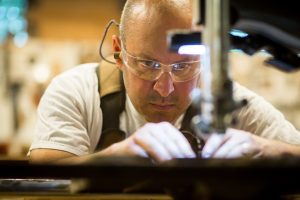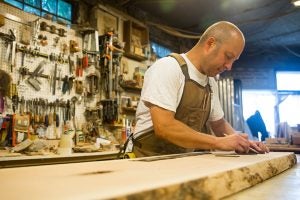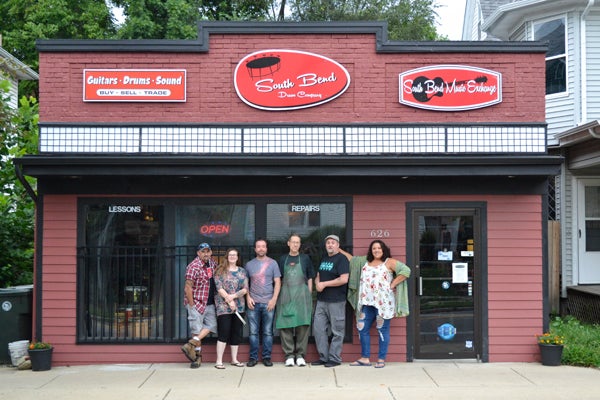South Bend artisan makes handcrafted furniture
After 20 years as a woodcrafter, Larry Piser still uses the first stepstool he ever crafted.
“That stepstool is something that I’ve kept coming back to,” he says. “That’s been the consistent [piece I make]. That stool has been steady.”
Larry is a South Bend native with a passion for wood. His shop, located on the east side of the St. Joseph River on Colfax, is overfilled with wood planks and scraps. Sawdust hangs from every available surface, the sign of a well-used shop.
His career as an artisan began during his college years when he decided to stop pursuing an English degree at IU Bloomington and head west to Taos, New Mexico. He was working as a manager for an outfitter in Taos and realized he needed some furniture.
“I moved out there with very few possessions, two of those being a Swiss army knife and a hammer,” he says. “There happened to be scrap wood that we were burning in the wood-burner for heat. I started cobbling things together and made a few little artistic pieces.”
He started telling some of his co-workers about the pieces he was creating and they were impressed. The seed had been planted.
“I didn’t have an artistic background,” he says. “I’d taken photography and maybe a drawing class in middle school, but I’d never worked in construction or never taken a shop class. But I met people who were doing things. [Taos] was a very hands-on, tire meets the road kind of place.”
After about four years of sporadic travel between South Bend and Taos, Larry decided to return to his hometown, make a go of his art as a business and finish his degree. Since then, he has perfected his craft, and he takes his job seriously. In a given year, he works on three to five large projects — think pieces for Notre Dame and St. Mary’s — and countless medium and small pieces for other clients. He always tries to add a bit of his own style to each piece.
“If somebody looks at something [I’ve made] and doesn’t know that I made it, then what’s the point?” he says. “It has to have my fingerprints on it, literally and figuratively.”
EVERYTHING IS THERE FOR A REASON
Larry begins each project with a sit-down meeting with his client in his shop. They discuss the expectations for the piece he will create, and they peruse a portfolio of his work. Sometimes he even asks to visit the client’s home in order to understand exactly how his work will fit into the space.
 “We’ll go to their home, or wherever the piece will eventually live. The best thing to do is get as many brains and as many eyeballs in the same place at the same time and just talk it through,” he says. “It’s a conversation: ‘What woods are we using? Where’s the light coming in, how are you going to enter the room? How are you going to interact with the piece?’ I don’t want my pieces to be an afterthought.”
“We’ll go to their home, or wherever the piece will eventually live. The best thing to do is get as many brains and as many eyeballs in the same place at the same time and just talk it through,” he says. “It’s a conversation: ‘What woods are we using? Where’s the light coming in, how are you going to enter the room? How are you going to interact with the piece?’ I don’t want my pieces to be an afterthought.”
After visualizing a plan for the piece, Larry gets to work designing how he will tackle the project. It’s not uncommon for the design process to take a week or more so that Larry is convinced that he knows every challenge he will face.
He splays out blueprints across his wood bench, begins selecting the correct pieces of wood, finds out what defects he may need to correct and begins marking up each piece. Larry says he views the woodworking process like telling a good story.
“Being selective about the wood helps me keep the story in order,” he says. “Each little piece is like a character or has a chapter and has a beginning and an end and an arc for its story. Sometimes there’s like a spell when I’m really into the work. All of a sudden it’s done and ‘POOF!’ the movie’s over and the story ends.”
That attention to detail and process is what makes the artisan. Larry becomes the director. Client rooms become his set, each piece of furniture an actor, and he becomes mindful of the overall story — how his pieces fit into the room as well as the story of the client.
“Everything in their home is telling their story, and I’m continuing that process,” he said. “I agonize sometimes over what pieces of wood to put where, and what piece [to use], so that it shows that someone was mindful and that someone paid attention to building this.”
A LEARNING PROCESS
Having never received a formal education in woodworking, Larry had to make a lot of mistakes to get to where he is. He says the most difficult challenge was learning the “proper” way that wood needs to be worked with.
 “You don’t get to do whatever you want with wood,” he says. “It’s a natural, living, breathing thing. You can only do so much. That’s why it’s called ‘working with wood.’ You’re not always in control. Not having a background in that, I sometimes design myself into corners. Then I’ve got to problem solve.”
“You don’t get to do whatever you want with wood,” he says. “It’s a natural, living, breathing thing. You can only do so much. That’s why it’s called ‘working with wood.’ You’re not always in control. Not having a background in that, I sometimes design myself into corners. Then I’ve got to problem solve.”
But that’s what he sees as the challenge of woodworking, and he enjoys finding a way he can design his way out of the puzzle.
Looking back, he wishes that he would have been encouraged to try woodworking more when he was in high school, but it had a stigma attached to it at the time.
“Back when I was in school, the shop classes were for the kids that weren’t going to college,” Larry says. “And that was seen as a bad thing; they were looked down upon. Now that I’ve done this, or that I’m doing this, [I see that] it’s just a different way your brain works. It needs to be taught in a different way. It can’t be at the end of the hall in a dank, stinky room.”
Still, he is able to view this process of woodworking with wonderment and is amazed on a daily basis that he gets paid to do what he loves.
“No one is more surprised by this whole thing than me, that this is where my life has taken me,” he says. “But, equally, I’m everyday surprised by a piece of wood. Like, ‘wow, that’s so beautiful. That’s so cool. Let’s make something cool out of this. It took this tree 80 years to do this. Let’s not waste it.’”
Larry’s mantra has always been, “It’s got to look nice and it’s got to do a job.” That’s where his original step stool fits in. Though he has modified his stool over the years, he models all of his current stools after the original.
“[Being an artisan] means being more artist than crafter,” he says. “Not just to be the builder, but to be inspired by what I’m making now to make bigger and better things next time.”
Back in 1996, Larry took a risk that he could walk the line of artist and crafter and quit his job to open his own business selling his pieces to the community. Though it has not always been easy, he continues to evolve his process to meet the demands of a changing society. Now, his pieces can sell for thousands of dollars.
“I’ve been a working artisan in South Bend for 20 years,” he says. “That’s somethin’.”
Photos by Mark Bugnaski





